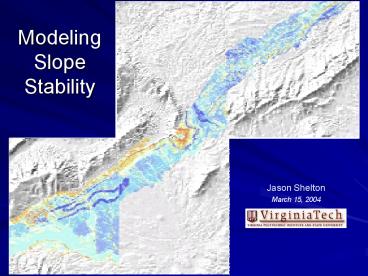Modeling Slope Stability PowerPoint PPT Presentation
1 / 19
Title: Modeling Slope Stability
1
Modeling Slope Stability
Jason Shelton March 15, 2004
2
Outline
- Objective
- Study Area
- Project Schematic
- Data Collection
- Stability Model
- Model Design
- Analysis of Model Results
- Stereonet Analysis
- Conclusions and Suggestions
3
Objective
- Model slope stability along a portion of the I-81
corridor in southwest Virginia. - How do we improve the model? What can we add?
4
Study Area
- The study area covers five USGS 7.5 minute
quadrangles Daleville, Villamont, Montvale,
Roanoke, and Salem.
Daleville
Montvale
Villamont
Salem
Roanoke
5
(No Transcript)
6
Data Collection
- Hardcopy geologic maps scanned and digitized
using AutoCAD, converted to shapefile, then to
grid in ArcGIS - 10 meter Digital Elevation Models
- TIGER data
7
Data Collection
8
Model Design
Safety Margin Resisting Forces (RF) Driving
Forces (DF)
- Slope angle (a)
- Cohesion (c)
- Friction angle (f)
- Unit weight of rock (g)
- Slab thickness (t)
9
Model Design
- slope grid was created from each DEM
- attribute tables of geologic shapefiles were
modified to include typical values of cohesion
(c) and friction angle (f) - unit weight (g) of rock used in this analysis was
150 lbs/ft2 - slab thickness (t) used in the initial analysis
was eight feet
10
Analysis of Model Results
- negative safety margin results when SDF gt SRF
(stability issues exist that should be addressed)
- very low, but positive safety margin values,
further investigation should be conducted.
(Options include comprehensive field study and
the use of stereonets to determine failure
potential.)
11
Analysis of Model Results
Model results covering the study area.
12
Analysis of Model Results
In the initial analysis, the Salem quadrangle
showed safety margin values as low as 0.02 in
some areas. These values were obtained using a
slab thickness of 8 feet.
13
Analysis of Model Results
- With a slab thickness of 5 feet, the new results
from the safety margin equation for the Salem
quadrangle show that decreasing the slab
thickness caused an increase in the safety
margin, indicating that fewer slopes are likely
to exhibit instability.
14
Analysis of Model Results
- A further revised slab thickness of 12 feet,
shows an overall decrease in the safety margin of
the slopes. This slab thickness value essentially
results in a more conservative estimate of slope
stability.
15
Analysis of Stereonets
Topple Failure
Friction Angle
Slope Face
Planar Failure
Wedge Failure
Slide Direction
16
Analysis of Stereonets
- Stereonets were created for areas of potential
instability on the Salem quad. These stereonets
show two potential failure areas in the planar
critical zones.
Planar Critical Zone
17
Analysis of Stereonets
Toppling Failure
Plane Failure
Wedge Failure
18
Conclusions
- Model only deals with rock slopes
- Incorporate soil and water into model
- Best suited for daylighting slopes?
- How can we incorporate bedding?
19
Conclusions
- Looks only at static safety, add critical
acceleration and shaking intensities to obtain
seismic susceptibility. (R. Jibson, E. Harp, J.
Michael - 2000)

